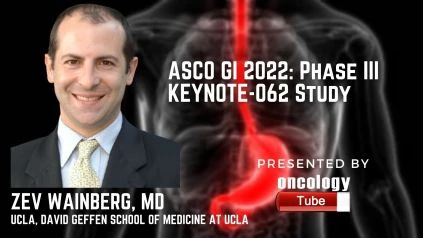Dr. Zev Wainberg is the Co-Director UCLA Gastro-Intestinal Oncology Program; Medical Director, UCLA Colorectal Cancer Center; Professor of Medicine, Division of Hematology, Oncology, David Geffen School of Medicine at UCLA. In this video, he speaks about the ASCO GI 2022 Abstract – ASCO GI 2022 entitled Pembrolizumab with or without chemotherapy versus chemotherapy for advanced gastric or gastroesophageal junction (G/GEJ) adenocarcinoma: The phase III KEYNOTE-062 study.
Â
Origins:
Pembrolizumab (pembro) as monotherapy and in combination with chemotherapy (chemo) versus chemo as first-line therapy for PD-L1–positive (combined positive score [CPS] 1) advanced gastric or gastroesophageal junction (GEJ) adenocarcinoma is being studied in KEYNOTE-062 (NCT02494583). Pembro was noninferior to chemo at the time of the protocol-specified final analysis, with fewer adverse events (AEs). For the overall survival (OS) and progression-free survival (PFS) end points assessed, pembro or pembro + chemo were not superior to treatment. After an additional 25 months of follow-up, we provide the results of KEYNOTE-062 (cutoff: April 19, 2021).
Â
Methodologies:
Pembro 200 mg Q3W, pembro + chemo (cisplatin 80 mg/m2/day on day 1 + 5-FU 800 mg/m2/day on days 1-5 Q3W [or capecitabine 1000 mg/m2 twice daily on days 1-14 Q3W according local guidelines]), or placebo Q3W + chemo were given to patients with previously untreated gastric or GEJ cancer. OS (RECIST v1.1; central review) in the CPS 1 and CPS 10 populations for pembro + chemo versus chemo and pembro versus chemo, as well as PFS (RECIST v1.1; central review) in the CPS 1 and CPS 10 populations for pembro + chemo versus chemo, were the primary end goals. Safety was also taken into consideration.
Â
Findings:
689 of 763 patients (90.3 percent) had died at the time of the data cutoff. 54.3 months was the median follow-up (defined as the time from randomization to data cutoff) (range, 46.8-66.1). In the CPS 1 population, Pembro was noninferior to chemo for OS (median, 10.6 vs 11.1 months; HR, 0.90; 95 percent CI, 0.75-1.08), but showed a clinically meaningful OS advantage in the CPS 10 population (median, 10.6 vs 11.1 months; HR, 0.90; 95 percent CI, 0.75-1.08). (median, 17.4 vs 10.8 months; HR, 0.62; 95 percent CI, 0.45-0.86). The 24-month OS rates (pembro vs chemo) in the CPS 1 cohort were 26.6 percent versus 18.8 percent, and 39.1 percent versus 21.1 percent in the CPS 10 population. In the CPS 1 (median, 12.5 vs 11.1 months; HR, 0.85; 95 percent CI, 0.71-1.02) and CPS 10 (median, 12.3 vs 10.8 months; HR, 0.76; 95 percent CI, 0.56-1.03) populations, pembro + chemo was not superior to treatment for OS. The 24-month OS rates (pembro + chemo vs chemo) in the CPS 1 cohort were 24.5 percent versus 18.8 percent, and 28.3 percent versus 21.1 percent in the CPS 10 population. In the CPS 1 (median, 6.9 vs 6.5 months; HR, 0.84; 95 percent CI, 0.70-1.01) and CPS 10 (median, 5.8 vs 6.2 months; HR, 0.71; 95 percent CI, 0.52-0.96) populations, pembro + chemo did not substantially prolong PFS compared to treatment. The rates of grade 3-5 AEs were 17.3 percent (pembro), 73.2 percent (pembro + chemo), and 69.3 percent (pembro + chemo) (chemo).
Â
Outcomes:
Efficacy and safety outcomes with first-line pembro or pembro + chemo versus chemo in patients with gastric or GEJ adenocarcinoma participated in KEYNOTE-062 were consistent with the final analysis data after an additional 25 months of follow-up. NCT02494583 is the number for the clinical trial.

